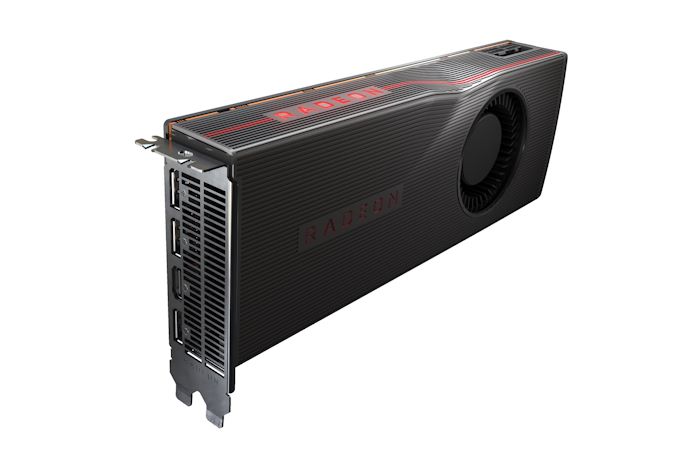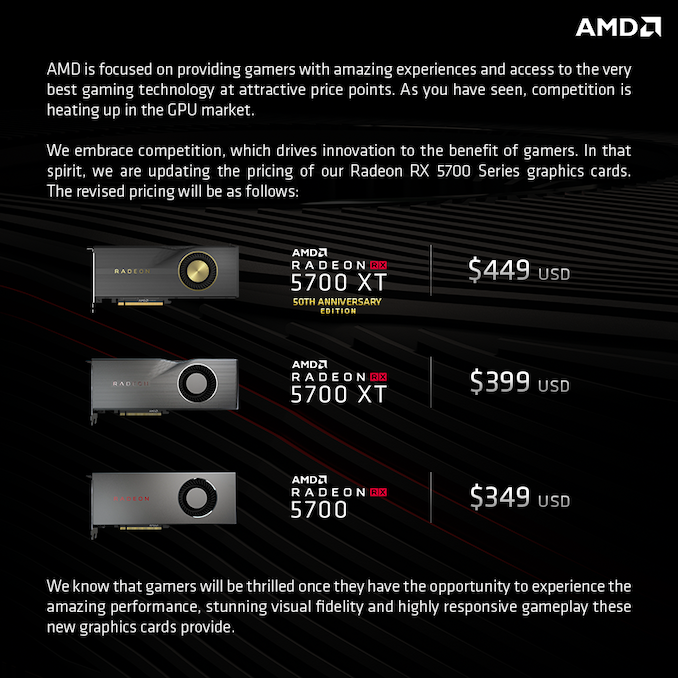AMD Adjusts Launch Price of Radeon RX 5700 Series: XT Down To $399, Standard Down To $349
by Andrei Frumusanu on July 5, 2019 5:30 PM EST- Posted in
- AMD
- GPUs
- Navi
- Radeon RX 5700

The new Radeon RX 5700 hasn’t even yet officially launched as we’re still awaiting Sunday the 7th of July, yet AMD in a rare event has now officially announced that is it adjusting the launch prices of the new Navi cards to lower price points.
Originally, the Radeon 5700 XT Anniversary edition, the XT, and the standard variant were priced at $499, $449, and $379. AMD has now lowered the price points to $449, $399 and $349.
| AMD Radeon RX Series Specification Comparison | ||||||
| AMD Radeon RX 5700 XT | AMD Radeon RX 5700 | AMD Radeon RX 590 | AMD Radeon RX 570 | |||
| Stream Processors | 2560 (40 CUs) |
2304 (36 CUs) |
2304 (36 CUs) |
2048 (32 CUs) |
||
| Texture Units | 160 | 144 | 144 | 128 | ||
| ROPs | 64 | 64 | 32 | 32 | ||
| Base Clock | 1605MHz | 1465MHz | 1469MHz | 1168MHz | ||
| Game Clock | 1755MHz | 1625MHz | N/A | N/A | ||
| Boost Clock | 1905MHz | 1725MHz | 1545MHz | 1244MHz | ||
| Throughput (FP32) | 9.75 TFLOPs | 7.9 TFLOPs | 7.1 TFLOPs | 5.1 TFLOPs | ||
| Memory Clock | 14 Gbps GDDR6 | 14 Gbps GDDR6 | 8 Gbps GDDR5 | 7 Gbps GDDR5 | ||
| Memory Bus Width | 256-bit | 256-bit | 256-bit | 256-bit | ||
| VRAM | 8GB | 8GB | 8GB | 4GB | ||
| Transistor Count | 10.3B | 10.3B | 5.7B | 5.7B | ||
| Typical Board Power | 225W | 180W | 225W | 150W | ||
| Manufacturing Process | TSMC 7nm | TSMC 7nm | GloFo/Samsung 12nm | GloFo 14nm | ||
| Architecture | RDNA (1) | RDNA (1) | GCN 4 | GCN 4 | ||
| GPU | Navi 10 | Navi 10 | Polaris 30 | Polaris 10 | ||
| Launch Date | 07/07/2019 | 07/07/2019 | 11/15/2018 | 08/04/2016 | ||
| Launch Price | $399 |
$349 |
$279 |
$179 |
||
The move isn’t unprecedented, but is something extremely rare. What is interesting is that AMD’s Scott Herkelman (CVP & GM AMD Radeon) yesterday posted an interesting but short tweet:
Jebaited
— Scott Herkelman (@sherkelman) July 4, 2019
Scott's snarky tweet is suggesting AMD had planned the move all along- playing a bait & switch in terms of the pricing of the RX 5700, most likely in preparation and in response to Nvidia’s newest Super card line-up.
We’re looking forward to covering the RX 5700 series cards when the time comes – hopefully soon!
Related Reading
Source: @Radeon on Twitter











78 Comments
View All Comments
Irata - Saturday, July 6, 2019 - link
There's a simple way to check this - look at AMD's and nVidia's total earnings and margin per chip sold.jospoortvliet - Saturday, July 6, 2019 - link
... and if you do you see they are both doing just fine in terms of profit margin. They certainly could slash prices but given their duopoly there is little reason. I think NVIDIA is fine with AMD taking a small part of the pie - after all, if AMD would stop making video cards NVIDIA might get issues with the market regulators in various countries.gdansk - Saturday, July 6, 2019 - link
That doesn't really work out. AMD has a hard time moving the volume to recoup R&D costs.Audacioucity - Sunday, July 7, 2019 - link
Neither AMD nor Nvidia disclose profit margins per SKU they offer. In the smallest unit, gross profit margins are figures of a particular division or more commonly the whole company.Dark42 - Saturday, July 6, 2019 - link
So the 5700 has more RAM and better performance than the 2060 for the same price.While the 5700 XT beats the 2070 / 2060 Super for the same price.
Well done AMD.
bananaforscale - Saturday, July 6, 2019 - link
We don't know that yet, and 2070 isn't relevant anymore with 2070 Super being the same price. What you want to compare to is just the 2060 Super because that's the only one that makes sense.Flunk - Saturday, July 6, 2019 - link
The non-super cards are discontinued.V900 - Sunday, July 7, 2019 - link
Lol no!7nm node is much more expensive than the 12 non node.
And yields aren’t going to be as high as with the 12nm node that Nvidia has been using for years.
alawadhi3000 - Friday, July 5, 2019 - link
Doesn't work that way, 7nm isn't cheap, plus probably have lowered yields than NVIDIA's 12nm.eek2121 - Friday, July 5, 2019 - link
7nm has better yields equal to 16nm according to TSMC.